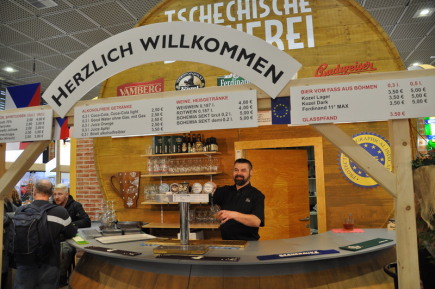In Berlin, the Grüne Woche is the highlight of the Food Fair, and Czechs are not missing either

Berlin: Berlin serves as the capstone city for the Grüne Woche food fair, which is regarded as the biggest of its kind in the world. After being postponed for two years due to the COVID-19 pandemic, the event was held at the Berlin Exhibition Center once more.
One thousand four hundred exhibitors from sixty nations include the Czech Republic as well. There is no representation for Russia or Ukraine due to recent international events.
Visitors typically have a preference for Czech beer, but fruit juices are also popular, according to Emerich Vacek, the manager of the Czech booth, who spoke to TK. The Internationale Grüne Woche trade show attracts participation from the Czech Republic on a regular basis.
This year, 17 businesses are exhibiting and they are selling a wide range of food items, such as fruit juices, sea buckthorn products, chocolate, mead, honey, sausages, and cheeses. A restaurant and a beer bar are undoubtedly a part of the Czech stand.
There are five different beers on tap here, and guests can sample traditional Czech specialties and game dishes in the restaurant, according to Vacek from the Czech Ministry of Agriculture. They took over the Czech participation in conjunction with the State Agricultural Intervention Fund (SZIF).
"Beer is probably the subject of the most interest, as is customary, but there is also a lot of interest in new products and exhibitors who are making their debut here. For instance, sea buckthorn products and fruit juices fall into this category, according to Vacek.
Visitors did, however, also pause to browse the assortment of cheeses, cold cuts, and even cut-outs. The turnout, according to Vacek, was excellent.
An enormous barrel-shaped pub in South Bohemian style serves as the focal point of the Czech exhibition area. The fair, which began on Monday of last week and runs through Sunday, also featured dulcimer music performed for the visitors by Hudci from Kyjov, who performed until Monday.
The fair, which has been a tradition since the 1920s of the previous century, offers space for the presentation of agriculture, the food industry, as well as items for the garden, according to Vacek. A lawnmower, sauna, or outdoor furniture are just a few examples of the non-food items that customers can view and buy here.
Companies can test new products here and gauge consumer response before deciding whether to put them on the market, according to Vacek, who added that this is somewhat fair for the final consumer. "There are many booths that draw visitors, whether it is the flower hall, which is customary at the Greene Woche fair, or the exposition of Holland and the exposition of individual German countries.
However, there are other nations that provide traditional specialties, like Armenia and form," said Vacek in reference to the national stands he would suggest visiting. On January 20, the day of the fair's opening, Zdenk Nekula, the Czech Republic's minister of agriculture, also stopped by.
On this particular occasion, he got together with some of his European colleagues there. He spoke with Wolfram Günther, the Saxon Minister of Energy, Climate Protection, and Agriculture, about a variety of topics, including organic farming, promoting the purchase of regional goods, and preventing the spread of bird flu and African swine fever.
This infection, which has spread to the Czech Republic, has plagued Saxony for a long time, just as it has Poland. African swine fever-infected dead wild boars were discovered in the Frdlant region in December of last year and January of this year.
Since 1926, Grüne Woche has been celebrated. Before the upcoming season, it serves as a dependable and significant test market for businesses in the food and agricultural sectors.
On 113,000 square meters, exhibitor from all over the world gathers there. The public views the fair primarily as a showcase of culinary art and food specialties from around the world, despite the fact that it provides businesses and professional visitors with an opportunity to make business contacts.
This year, the fair's regular entry fee, which costs 15 euros (360 CZK), will be charged to the roughly 400,000 visitors who attend it on a yearly basis. Food and agriculture fair in Germany.
The fair, which has been a tradition since the 1920s of the previous century, offers space for the presentation of agriculture, the food industry, as well as items for the garden, according to Vacek.
Post a Comment for "In Berlin, the Grüne Woche is the highlight of the Food Fair, and Czechs are not missing either"